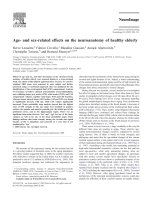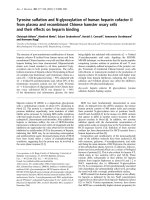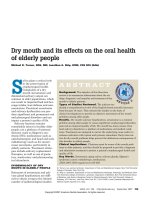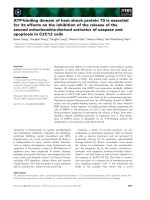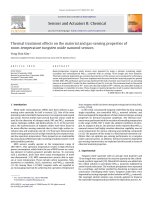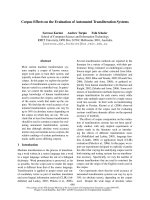Mechanisms of polymer ca2+ interaction and their effects on the characteristics of alginate microspheres and films 2
Bạn đang xem bản rút gọn của tài liệu. Xem và tải ngay bản đầy đủ của tài liệu tại đây (2.06 MB, 32 trang )
98
Part II. Influence of different cross-linking methods on the properties of alginate
microspheres produced by emulsification.
A. Production of the alginate microspheres by the emulsification/external cross-
linking method
A1. Preparation of partially cross-linked alginate for microsphere production
A small amount of calcium chloride was incorporated into sodium alginate to
produce a partially cross-linked alginate in solution. The calcium chloride solution
was added slowly with vigorous stirring to avoid rapid clumping of the alginates due
to cross-linking (Figure 4). Concentrations of the calcium chloride above 0.08% w/w
in calcium chloride-alginate mixture led to an almost instantaneous sol-gel
tranformation in the absence of high shear stirring, making it impossible to use the
mixture for microsphere formation by emulsification. Therefore, 0.08 % w/w of
calcium chloride was carefully incorporated as it allowed the mixture to remain in the
fluid state for a sufficient period of time after stirring had stopped.
During the shearing process, heat was generated which might cause
degradation of the macromolecular alginate polymer into lower molecular weight
fragments. An exponential decrease in the viscosities of alginate solutions with
decreasing molecular weight of the polymer had been reported
(Kong
et al., 2003).
Hence a change in the viscosity of the solution could be used to indicate polymer
degradation. No significant difference in viscosities was observed between SA
solution and S1 mixture (p>0.05), indicating that the shearing action and associated
heat produced was unlikely to cause degradation of the alginate used (Figure 4 and
Table 13).
99
Table 13. Viscosities of alginate solutions subjected to high shear with/without partial cross-linking and the properties of resultant microspheres.
Properties of microspheres
Code Solution/ mixture
viscosity
(mPas)
Mean size
(µm)
Sphericity Drug content (mg)
t
75%
(min)
SA
169.62 ± 0.98 192.64 ± 3.85 1.04 ± 0.001 14.02 ± 0.03
17.1
S1
172.28 ± 0.59 197.6 ± 3.85 1.04 ± 0.002 14.13 ± 0.02
22.9
S2
166.20 ± 3.17 216.62 ± 4.86 1.05 ± 0.003 13.35 ± 0.01
14.3
S3
242.76 ± 1.16 219.82± 7.96 1.05 ± 0.002 13.87 ± 0.03
14.3
99
100
A2. Properties of microspheres produced from the partially cross-linked alginate
Different amounts of Ca
2+
were added to the partially cross-link sodium
alginate before it was used to produce microspheres by the emulsification/external
cross-linking method. The microspheres obtained were compared with those prepared
from sodium alginate (i.e. without partial cross-linking). This study was aimed at
evaluating the effect of the cross-linking technique on the properties of the
microspheres produced.
The microspheres produced from the different alginate mixtures were
spherical, with mean diameters ranging from 192 to 220 µm (Figure 13 and Table 13).
S3 microspheres had the widest size distribution among the different batches. SA and
S1 microspheres were significantly smaller than S3 microspheres (p<0.05) (Table 13).
The same emulsification conditions were used for all the alginate solutions/mixtures.
The larger S3 microspheres were attributed to less effective dispersion of the more
viscous S3 mixture into globules as small as those of SA and S1 solutions. A
comparison of drug content and mean size of the microspheres suggested that size
was not a primary factor affecting drug encapsulation efficiency (r
2
=0.476). The
higher drug content of both SA and S1 microspheres as compared to S2 and S3
microspheres (p<0.05) showed that the use of partially cross-linked alginate in the
preparation of microspheres reduced the drug encapsulation efficiency. The results
suggested that a more orderly arrangement of the polymeric chains resulted in less
flexibility and a poor ability in entrapping drug particles. Being larger in size, S2 and
S3 microspheres had a smaller specific surface area than SA and S1 microspheres for
drug release. In spite of this, the rate of drug release from S2 and S3 microspheres
was found to be comparable with that of SA and S1 microspheres. The t
75%
values of
SA and S1 microspheres were 17.1 min and 22.9 min respectively and 14.3 min for
101
(a) (b)
(c) (d)
Figure 13. Photographs of (a) SA (b) S1 (c) S2 and (d) S3 microspheres.
101
102
both S2 and S3 microspheres (Table 13). This showed that the matrix of the S2 and
S3 microspheres was more permeable to drug release than that of SA and S1
microspheres. It could therefore be inferred that partial cross-linking of alginate had
fixed the arrangement of the polymer chains with respect to one another, thereby
reducing subsequent interaction which involved binary binding sites via the divalent
calcium ion. The more permeable matrix of S2 and S3 microspheres was expected to
favour greater drug loss through diffusion during washing of the microspheres. This
could partially explain the lower drug content of the S2 and S3 microspheres. The
higher viscosity of S3 mixture as compared to S2 mixture would impede the diffusion
of the drug from the polymer phase to the organic phase during emulsification
resulting in a higher drug content of S3 microspheres (p<0.05)(Table 13).
Although discrete and spherical calcium alginate microspheres were
successfully produced from the partially cross-linked alginate solution using an
emulsification method, this technique of cross-linking was not recommened for the
development of drug carriers. Partial cross-linking of the alginate reduced the
subsequent interaction with Ca
2+
, resulting in lower drug encapsulation efficiency and
relatively rapid drug release.
B. Production of alginate microspheres by the emulsification/internal cross-
linking method
B1. Determination of the amount of CaCO
3
and volume of glacial acetic acid
needed.
Calcium carbonate was added to a beaker of water (50 g) and dispersed with a
magnetic stirrer (Figure 14). Glacial acetic acid was added slowly and the pH was
monitored. The minimum volume of glacial acetic acid needed to fully react with the
103
Figure 14. Setup for the determination of amount of CaCO
3
and volume of glacial
acetic acid needed.
104
CaCO
3
was determined.The end point was marked by the first sign of complete
disappearance of white CaCO
3
particles. The reaction between H
+
and CaCO
3
was
rapid and was completed within 15 min. Thus, it could be inferred that all the Ca
2+
had been released from the CaCO
3
during emulsification after 15 min. The pH of the
solutions formed was observed to be above pH 4 and would not affect the stability of
the alginate.
B2. Treatment of alginate microspheres produced
The alginate microspheres were produced and subjected to different treatments
as shown in Figure 5. The amount of CaCO
3
was varied in order to evaluate the
influence of different amounts of the cross-linker on the alginate microspheres. M1
microspheres were discrete and spherical prior to in vacuo filtration. They appeared
distorted in shape after filtration and formed massive clumps after oven-drying. This
was attributed to the deformation of the alginate matrices when subjected to strong
compression pressure during in vacuo filtration and adhesion of microspheres in close
contact with one another during drying in the oven. Similar observations were made
for M2 microspheres despite crosslinking with more Ca
2+
than the M1 microspheres
(Figure 5).
In an attempt to increase the matrix strength and remove as much moisture as
possible from the wet microspheres, glutaraldehyde and isopropyl alcohol were
added. Glutaraldehyde had been used as a crosslinking agent in the preparation of
calcium alginate beads
(Kulkarni et al., 2000) as well as a hardening agent for beads
made from pectin
(Sriamornsak and Nunthanid, 1998). Similarly, isopropyl alcohol
had been used to harden and dehydrate alginate microspheres (Wan et al., 1992).
105
The treated microspheres were found to be discrete and spherical after in
vacuo filtration. However, they still exhibited a distorted shape and marked clumping
after drying in an oven. Both glutaraldehyde and isopropyl alcohol were unable to
produce adequate hardening of the microspheres. Although the amounts of CaCO
3
,
glutaraldehyde and isopropyl alcohol used were more than sufficient for the intended
function, they failed to produce the desired discrete microspheres. Carbon dioxide
was liberated from CaCO
3
in the presence of an acid. It was probable that the above
observations were due to the rapid liberation of carbon dioxide. This resulted in the
formation of porous microsphere matrices which were weaker and easily succumbed
to the pressure of filtration.
Freeze-drying was attempted to dry the product. As freeze-drying is also
suitable for drying thermolabile materials and causes minimal structural changes to
the product, it was used to eliminate the adverse effects of in vacuo filtration and oven
drying on the structural integrity of the alginate microspheres. The M5 and M6
microspheres produced with 0.5 g and 0.8 g of CaCO
3
were found to be discrete but
‘millet’ in shape (Figure 15).
Significantly less clumping was observed when the microspheres were freeze-
dried, as compared to those that were oven-dried. Additional cross-linking for 30 min
with calcium chloride
solution produced less clumping of the microspheres. The
microspheres produced with 0.8 g of CaCO
3
showed less clumping than those
produced with 0.5 g of calcium carbonate. Interestingly, 1.0 g of CaCO
3
produced
distorted microspheres with a higher degree of clumping. This might be attributed to
the excessive production of carbon dioxide when a large amount of CaCO
3
was used,
resulting in adverse structural effects, producing more porous and weaker
microsphere matrices.
106
Figure 15. Photographs of freeze-dried microspheres produced with (a) 0.5 g and (b)
0.8 g of CaCO
3
obtained using a light microscope under 400X magnification.
(a)
(b)
107
The properties of microspheres produced by different cross-linking methods
clearly showed a strong influence of cross-linking techniques on the integrity of the
calcium alginate matrix formed. Partially cross-linked alginate microspheres and
externally cross-linked alginate microspheres could be successfully produced by
emulsification. The calcium alginate microspheres were discrete, spherical,
sufficiently strong to be harvested and could be handled with ease. However, calcium
alginate microspheres produced by an internal cross-linking method were ‘millet in
shape’ and appeared weak (Figure 15). The results obtained seemed to suggest that
the different techniques of producing microspheres involved different cross-linking
mechanisms that affected the matrix structure differently and the properties of the
matrix to different extents. Unravelling the cross-linking mechanisms and their effects
on matrix integrity would assist in the control of the interaction between Ca
2+
and
alginate with the use of more appropriate cross-linking techniques.
C. Mechanisms of external and internal cross-linking of the alginate matrix
C1. Alginate film as a matrix model
Films were used as matrix models as standard test samples could be easily
prepared to evaluate the properties of the matrix and the influence of size and shape
could be avoided. The properties that affected the quality of the alginate matrix such
as thickness, extent of cross-linking, tensile strength, elastic modulus, solubility,
degree of hydration and drug permeability were evaluated. In addition, the surface
topography of the matrix was determined as this parameter was reported to affect the
success rate of encapsulated cells in immuno-isolation devices (Lanza et al., 1991).
C1.1. Process parameters for cross-linking
108
C1.1.1. Type of cross-linking agent used
When insoluble calcium salts are used, the Ca
2+
must be released for cross-
linking action at pH values above the pKa of alginates. Immersion of alginates in
media with a pH lower than the pKa value would result in the conversion of the
alginates to alginic acid. Hence, some insoluble calcium salts such as calcium oxalate
and calcium tartrate are not suitable as the Ca
2+
are not released within a suitable pH
range.
CaCO
3
was chosen as the cross-linking agent as the Ca
2+
could easily be
released from the insoluble carbonate by lowering the pH of the medium to pH 6.5
(Poncelet et al., 1995). Only a small volume of glacial acetic acid was required to
bring about the required pH change. CaCO
3
was used in both external and internal
cross-linking studies to maintain similarity in the source of Ca
2+
used and minimize
experimental variability.
C1.1.2. Amount of cross-linking agent used
Films when externally cross-linked using less than 0.15 g of CaCO
3
were
fragile and broke into small pieces when handled. Therefore, the films were cross-
linked using at least 0.15 g of CaCO
3
. Different amounts of CaCO
3
were used in the
study to evaluate the influence of various amounts of cross-linking agent on the
gelation mechanisms.
C1.1.3. Medium used for cross-linking of alginate matrices
A review of the literature showed that the media used for internal and external
cross-linking methods were not standardized and often, the pH values of the media
used were was not reported. Thus, comparisons between studies and results are not
109
meaningful (Choi et al., 2002; Liu et al., 2002; Quong et al., 1997; Vanderberg and
De La Noüe, 2001). In this present study, an aqueous medium was used within a small
pH range so that the effects of internal and external cross-linking methods on the
properties of the cross-linked matrix could be compared. A number of studies had
reported the formation of less dense internally cross-linked alginate matrices with
larger pore sizes when compared to externally cross-linked products (Choi et al.,
2002; Liu et al., 2002; Quong et al., 1997; Vanderberg and De La Noüe, 2001). Liu et
al. (2002)
attributed this to the displacement of Ca
2+
by H
+
from the acid added. While
the acid liberated Ca
2+
from the insoluble salt, it also competed with Ca
2+
for
interaction with the alginate. Therefore, the pH range of the cross-linking media had
to be carefully controlled. Addition of glacial acetic acid enabled liberation of Ca
2+
from the insoluble calcium salt was attempted, but it also reduced the pH of the
medium drastically. Hence, sodium acetate was also added in the medium to keep the
pH relatively constant, at about 4.
C1.2. FTIR of alginate films
The presence of a very strong peak at a wavenumber of around 1737cm
-1
for
alginic acid has been reported by Dupuy et al. (1994). The occurance of the peak was
suggested to be due to the carbonyl (C=O) stretch, attributed to the free carboxyl (-
COOH) group present in alginic acid. In this study, strong peaks around 1737 cm
-1
were absent in the FTIR spectra of the calcium cross-linked alginate films, indicating
potential interactions involving C=O groups (Figure 16). It could therefore be inferred
that the pH of the medium used promoted interactions between Ca
2+
and alginate. The
displacement of Ca
2+
by H
+
could be controlled by careful manipulation of the pH of
the medium. The FTIR spectra of the cross-linked alginate films
110
Figure 16. FTIR spectra of alginic acid and alginate matrices.
1737 cm
-1
111
appeared similar, without significant detectable changes in the matrix due to different
cross-linking mechanisms.
C1.3. Morphology, surface topography and calcium content of alginate matrices
Films were produced by both external and internal cross-linking methods
using various amounts of CaCO
3
(Table 5). The dried cross-linked alginate films were
relatively transparent. Examination of internally cross-linked films under 40X
magnification showed the presence of abundant minute cavities which were not seen
in the externally cross-linked films. Cross-linking by either method increased the
surface roughness of the films (Table 14 and Figure 17). It was postulated that Ca
2+
in
the external cross-linking method interacted extensively with the film surface first as
contact began at the surface. This initial cross-linking action drew the polymer chains
closer together to form a less permeable surface to the diffusion of Ca
2+
into the
interior. Consequently, a less homogeneous alginate matrix formed, due to a relatively
poor cross-linked interior and a highly cross-linked film surface. A homogeneous
cross-linked matrix is essential for uniform contraction of the matrix during drying,
which, in turn, is critical to the formation of a smooth surface. The surface roughness
and Ca
2+
content of externally cross-linked alginatefilms increased significantly
(p<0.05) when the amount of CaCO
3
used was increased from 0.15 g to 0.25 g (Table
14). Further increase in the amount of CaCO
3
to 0.35 g did not have a significant
impact on surface roughness thereby indicating that 0.25 g was sufficient to produce a
highly cross-linked surface that was able to impede diffusion of Ca
2+
into the interior.
However, in earlier studies, alginate microspheres were found to release drug rapidly
(Chan et al., 1997; Wan et al., 1994). Since some of the drug molecules studied were
larger than Ca
2+
, the hinderance to Ca
2+
diffusion could not be attributed to reduced
112
Table 14. Surface roughness, mechanical properties and calcium content of dried
calcium alginate films.
Film Code Ra Value
(nm)
Tensile
Strength
(N/mm
2
)
Elastic Modulus
(N/mm
2
)
Ca
2+
content
(mg/g of film)
SA
44.68 ± 3.00
78.78 ± 2.13
1674.66 ± 81.41
-
CAE 0.15
45.09 ± 0.77
89.28 ± 3.55
3141.97 ± 91.28
67.01 ± 0.89
CAE 0.25
53.53 ± 1.16
95.89 ± 2.78
3017.95 ± 127.73
76.42 ± 1.72
CAE 0.35
52.62 ± 1.26
99.86 ± 4.92
2533.22 ± 163.79
79.48 ± 1.84
CAI 0.15
51.03 ± 1.23
88.23 ± 3.16
2974.40 ± 112.15
65.71 ± 0.39
CAI 0.25
59.00 ± 1.62
86.56 ± 4.67
2646.34 ± 79.91
73.55 ± 0.48
CAI 0.35
66.22 ± 2.21
87.23 ± 2.13
2210.71 ± 220.17
76.24 ± 0.72
CAI 0.25S -
84.51 ± 3.26
3230.33 ± 199.01 -
CAI 0.25N -
90.22 ± 1.61
3270.21 ± 287.63 -
113
Figure 17. Scanning probe microscope images of alginate films.
SA
CAE 0.25
CAE 0.15 CAI 0.15
CAI 0.25
CAI 0.35
CAE 0.35
114
porosity of the matrix. It was more likely that the Na
+
displaced by Ca
2+
led to gradual
development of a positively charged microenvironment, which produced a repelling
effect on diffusion of Ca
2+
.
In the internal cross-linking method, insoluble CaCO
3
was uniformly
distributed in the sodium alginate matrix. Liberation of Ca
2+
for cross-linking was
accompanied by an evolution of carbon dioxide which created abundant minute
cavities throughout the cross-linked matrix. The evolution of carbon dioxide near the
surface aptly accounted for the rougher surfaces of internally cross-linked alginate
films, compared to externally cross-linked or non-cross-linked sodium alginate films.
A linear relationship (r
2
=0.999) between surface roughness of internally cross-linked
films and amounts of CaCO
3
used was observed. It was clearly seen that surface
roughness was significantly affected by the gelation mechanism and the amount of
calcium salt used. Internal cross-linking and larger amounts of CaCO
3
are therefore
not recommended for cross-linking of alginate matrices in certain applications such as
the provision of immuno-protection to cells in immunoisolation devices since the
success rate of transplantation is adversely affected by surface roughness of the matrix
membranes (Lanza et al., 1991).
C1.4. Thickness and weight of the alginate films
The thickness of the resultant alginate films is shown in Table 15. With the
exception of CAE 0.35 films, the rest were markedly thinner than the corresponding
films before cross-linking. Although a smaller amount of CaCO
3
was used, CAE 0.15
films were significantly thinner than CAE 0.25 films (p<0.05). These findings were
not in agreement with those reported in the literature, which seemed to indicate that a
115
Table 15. Thickness and weight of dried alginate films.
Film Code
Thickness (mm)
Weight (g)
Before
Cross-linking
After
Cross-linking
% Change
Before
Cross-linking
After
Cross-linking
% Change
CAE 0.15
0.0495 ± 0.0005 0.0268 ± 0.0011
-45.86
0.55 ± 0.006 0.52 ± 0.005
-6.52
CAE 0.25
0.0495 ± 0.0005 0.0352 ± 0.0009
-28.89
0.55 ± 0.005 0.55 ± 0.004
+0.36
CAE 0.35
0.0495 ± 0.0005 0.0510 ± 0.0013
+3.03
0.55 ± 0.008 0.56 ± 0.008
+3.30
CAI 0.15
0.0659 ± 0.0019 0.0383 ± 0.0009
-41.88
0.57 ± 0.003 0.53 ± 0.005
-7.72
CAI 0.25
0.0719 ± 0.002 0.0513 ± 0.0001
-28.65
0.58 ± 0.002 0.57 ± 0.003
-2.92
CAI 0.35
0.0820 ± 0.0008 0.0574 ± 0.0012
-30.00
0.59 ± 0.001 0.57 ± 0.003
-2.88
115
116
larger amount of calcium salt produced a greater degree of cross-linking and
consequently thinner films. The change in film weight was found to be minimal
compared to the change in film thickness after cross-linking. Stochiometrically, one
mole of calcium ions (atomic weight ≈ 40 g) displaces two moles of sodium ions
(total atomic weight ≈ 46 g). As there is little difference between the corresponding
weights of the cations exchanged, the weights of the film before and after cross-
linking were expected to be comparable. Any significant change in weight would
imply a loss in polymer content through dissolution during the cross-linking process.
The percent reduction in thickness of films externally cross-linked with 0.15 g of
CaCO
3
(45.86 %) was markedly higher than the corresponding reduction in weight
(6.52 %). Hence, the loss in polymer content could only account for the reduction in
film thickness to a small extent. CAE 0.25 films were significantly thinner (p<0.05)
than CAE 0.35 film but both films were of comparable weights and Ca
2+
contents.
These findings supported an earlier postulation of greater surface cross-linkage and
lower Ca
2+
permeation at high calcium salt concentration in the external cross-linking
method. In contrast, the greater Ca
2+
permeation at lower calcium salt concentration
promoted cross-linkages across the matrix, resulting in a greater shrinkage and thinner
films. The amount of glacial acetic acid used in this study was predetermined to bring
about complete liberation of Ca
2+
from the insoluble CaCO
3.
Protons, which are
smaller in size than Ca
2+
diffuse more rapidly and with greater ease into the alginate
matrix (Quong et al., 1998). Hence, all the CaCO
3
used for internal gelation was
available for cross-linkage. No significant difference (p>0.05) was observed in the
Ca
2+
content of CAI 0.25 and CAI 0.35 films indicating that 0.25 g of CaCO
3
was
sufficient to effect maximum cross-linking (Table 14). Interestingly, the Ca
2+
contents
between the corresponding films externally and internally cross-linked with different
117
amounts of CaCO
3
, were comparable (p>0.05) but CAI 0.15 and CAI 0.25 films were
thicker than the corresponding externally cross-linked films. This showed that the
different cross-linking mechanisms resulted in comparable extent but different
distribution of cross-linkages, giving rise to structurally different matrices. The
thickness of internally cross-linked matrices was dependent on the balance between
opposing effects of cross-linkage and CO
2
produced, whereas the thickness of
externally cross-linked films was controlled by the distribution pattern of cross-
linkage. Cross-linking of alginate by Ca
2+
would bring the polymer chains closer
together leading to film contraction and decreased film thickness. On the other hand,
evolution of CO
2
from the reaction between H
+
and CaCO
3
resulted in the formation
of abundant minute cavities, hence, contributing to volumetric increase of the
internally cross-linked matrix. Both effects were expected to increase with greater
amounts of calcium salt used. The results clearly showed that CO
2
released had a
greater contribution to film thickness than matrix contraction due to cross-linking.
C1.5. Mechanical properties of alginate films
The tensile properties of the different types of films produced are listed in
Table 14. Cross-linked alginate films were significantly stronger than sodium alginate
films (p<0.05) indicating that the extent of cross-linkage increased the mechanical
strength of the matrix. Statistical analysis showed minimal differences in the tensile
strength between film matrices cross-linked externally with different amounts of
CaCO
3
(p>0.05). However, CAE 0.25 and CAE 0.35 had a greater extent of cross-
linking as reflected by their significantly higher calcium contents than CAE 0.15
(p<0.05) (Table 14). This implied that the distribution of cross-linkage had a strong
influence on the mechanical strength of films, with a more uniformly cross-linked
118
matrix resulting in the formation of stronger films. In internally cross-linked films, the
increased availability of Ca
2+
was accompanied by higher level of CO
2
liberation.
Hence, formation of films of comparable tensile strength resulted as the positive
effect of cross-linking was counterbalanced by the negative effect of CO
2
generated.
The detrimental effect of CO
2
generation was further illustrated by the formation of
stronger externally cross-linked films compared to the corresponding internally cross-
linked ones (p<0.05).
The liberation of CO
2
disrupted the alginate matrix by forming cavities,
thereby compromising its tensile strength. The effect of cavities was further
investigated by employing CaCO
3
batches of different particle size (Table 1). Smaller
particles of CaCO
3
were expected to produce smaller and more uniformly distributed
cavities. However, no difference in tensile strength between CAI 0.25 CAI 0.25S and
CAI 0.25N was observed (p>0.05), indicating that size and number of cavities were
equally important to mechanical strength of the film. The two cross- linking
mechanisms gave rise to similar extent of binding between Ca
2+
and alginate as
illustrated by an insignificant difference in Ca
2+
contents between CAE 0.15 and CAI
0.15 and between CAE 0.25 and CAI 0.25 (Table 14). The cross-linked films had a
higher elastic modulus than sodium alginate films, indicating lower flexibility of the
cross-linked matrix (Table 14). Despite insignificant differences in Ca
2+
content, the
externally cross-linked films had a higher elastic modulus than the corresponding
internally cross-linked films. This further supported the postulation that the two cross-
linking mechanisms produced films with a comparable extent of cross-linkage but
with different matrix structures. The greater flexibility of internally cross-linked films
could be attributed to the microscopic cavities dispersed in the matrix. Increasing the
amount of CaCO
3
used to produce the films increased the flexibility of both externally
119
and internally cross-linked films though it had insignificant effect on their tensile
strength. This confirmed the contributory effect of cavities on film flexibility. It also
showed that a film with poorly cross-linked interior, albeit a highly cross-linked
surface, was more flexible than a uniformly cross-linked film. More importantly, the
flexibility of the films could be modified, without affecting their mechanical strength,
by varying the amount of CaCO
3
used to produce the films. In addition, the flexibility
of internally cross-linked films could be increased by employing CaCO
3
of smaller
particle size (p<0.05).
The mechanical properties of alginate matrices were significantly affected by
the gelation mechanisms and the amounts of CaCO
3
used. External gelation appeared
to produce stronger films while internal gelation produced more flexible films.
C1.6. Apparent solubility of alginate films
Sodium alginate films dissolved within minutes after immersion in water at a
temperature of 37°C. On the contrary, calcium alginate films were practically
insoluble as less than 8 %w/w of the film was found to dissolve in water after 6 h
(Figure 18). Statistical analysis showed an insignificant change in dry film weight
before and after immersion in water (p>0.05). This implied that the calcium alginate
films used in the permeability studies would remain intact throughout the experiment.
Nonetheless, the apparent solubility of cross-linked films was found to increase with a
decreasing amount of CaCO
3
used to effect the cross-linking. This was attributed to
the presence of a higher proportion of unreacted sodium alginate, which was more
soluble than calcium alginate.
120
Figure 18. Apparent solubilities of externally cross-linked and internally cross-linked
alginate films at 37 ºC.
0
1
2
3
4
5
6
7
8
9
0.15 0.25 0.35
Amount of CaCO
3
used (g)
Apparent solubilities of
alginate films (% )
Externally cross-linked films
Internally cross-linked films
121
C1.7. Permeation study of alginate films
After an initial lag time, the amount of acetaminophen diffusing across the
calcium alginate matrix as a function of time became constant (Figure 19). The
diffusion of water-soluble acetaminophen was expected to occur through aqueous
pores or channels present in the film matrix. Increased cross-linking diminished the
number of pores or channels in the film as reflected by the higher permeability
coefficients and hydration indices of CAE 0.15 and CAI 0.15 compared to those of
CAE 0.25 and CAI 0.25 respectively (Table 16). Earlier results showed that CAE 0.25
and CAE 0.35 were cross-linked to comparable extents, with the latter having a more
highly cross-linked surface. The difference in permeability coefficients between CAE
0.25 and CAE 0.35 suggested that the distribution of cross-linkages in the matrix had
a significant effect on drug permeation. A more highly cross-linked surface was more
effective than a more uniformly cross-linked matrix in impeding drug permeation, as
reflected by a lower permeability coefficient for CAE 0.35 (Table 16). More rapid
release of drugs from homogeneous alginate gel beads than inhomogeneous alginate
gel beads had been observed by Martinsen et al. (1992). Earlier results also showed
comparable extents of cross-linkage between CAE 0.15 and CAI 0.15 and between
CAE 0.25 and CAI 0.25 (Table 14), with the internal cross-linking method producing
a more uniformly cross-linked matrix. However, the internally cross-linked films had
lower permeability coefficients than the corresponding externally cross-linked films
(p<0.05) (Table 16). This suggested that the microscopic cavities formed by the
liberation of CO
2
in internally cross-linked films impeded drug diffusion. Matrices
which were internally cross-linked with a larger amount of CaCO
3
were expected to
have numerically more or large cavities. All these matrices were found to have lower
hydration indices (Table 16). It could be inferred that the cavities served as air
122
Figure 19. Drug permeation profiles of calcium alginate films.
0 100 200 300 400
0
100
200
300
400
500
Time (mins)
Amount of acetaminophen diffused through the
calcium alginate film (µg/cm
2
)
CAE 0.15
S CAE 0.25
z CAE 0.35
CAI 0.15
U CAI 0.25
{ CAI 0.35


